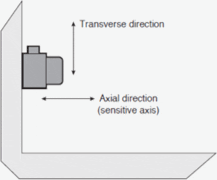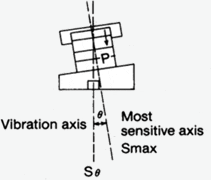Question
Please explain the accelerometer transverse sensitivity specification and its importance to my measurement?
Answer
Transverse sensitivity, often called "cross-axis sensitivity" and "crosstalk", is a very important specification in most applications. This is also an area where a buyer should beware; more on this later.
Accelerometer transverse sensitivity is a transducer's sensitivity at 90° to the sensitive axis. See Figure 1. This parameter is expressed as a percentage of axial sensitivity. An ideal accelerometer would have zero transverse sensitivity. However, realistically, due to certain manufacturing tolerances used within the transducer assembly process (see Figure 2), or due to polarization errors in the piezoelectric crystals, low values of transverse sensitivity are to be expected. A high-quality accelerometer will have typical transverse sensitivity values from 3% to 5%. Values of as low as 1% are also available on some models, usually for an additional cost.

Figure 1: A mounted accelerometer, indicating both sensitive and transverse axes
Transverse sensitivity is also an issue in piezoresistive devices. The problem is almost always an internal mounting issue, similar to what is shown in Figure 2.
Referring to Figure 2, a user can also cause an increase in cross-axis sensitivity by employing improper mounting techniques. It can easily be seen that, if an accelerometer is not perpendicular to the mounting surface, a tilted accelerometer will have the same effect as the tilted seismic system.
So then, why should we be concerned about this parameter? In order to ensure any degree of test data reliability, we need to be analyzing data in the sensitive axis, which should be our direction of interest. In the event that data is required in several directions, a triaxial accelerometer should be selected. The triaxial accelerometer measures vibration in three orthogonal directions; thus, the user can now determine the amplitude of vibratory motion as a function of direction.
In the real world, most structures exhibit motion in all directions. Even large shakers exhibit transverse motion characteristics. Others, such as machinery or automotive structures, are just a few additional examples.

Figure 2: Exaggerated example of a misaligned accelerometer mechanical assembly, causing excessive transverse sensitivity
Here is where a buyer should be well-informed, and also, beware. Many accelerometer manufacturers will provide a transverse sensitivity specification that was determined during the product development phase. Unfortunately, due to manufacturing errors, actual transverse sensitivity can be as high as 15%. As part of its vertically integrated in-house proprietary manufacturing processes, Endevco uses special machines to test almost all accelerometers post-production for transverse sensitivity, with the actual value recorded on the calibration certificate. While this extra testing adds a bit more overhead cost to a product, it ensures a user of more highly accurate, repeatable measurements. In addition, the measure of this parameter is also an objective way for a manufacturer to more accurately monitor device quality.